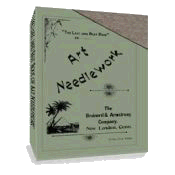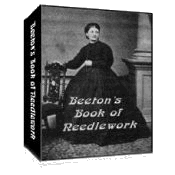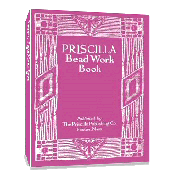Cross-stitch Embroidery
Cross-stitch embroidery has not changed much over the past century. As can be seen from the instructions given below, today's embroiderers receive the same basic information as did embroiderers in 1898.
The following was printed in "Needle-Craft", published by the Butterick Publishing Company:
Cross-Stitch
Embroidery Hoop or Frame. A hoop or frame is necessary to hold the fabric taut while stitching. For more information on Victorian Embroidery hoops, see Hoops and Frames.
As past embroiderers were advised, be sure to leave enough fabric around the edges to allow the hoop to have a strong hold. This can be managed by placing the piece of fabric to be embroidered over the smaller hoop, leaving at least 1½ "inches of fabric all around to hang over, so when the larger hoop is placed on top and tightened, the fabric is pulled tight evenly across the circle. (You may want even more of a fabric margin depending on the use of your project.) Tightened the larger hoop, pulling the fabric as needed to make it as tight as possible.
To ensure your embroidery is not pulled out of shape or marks left on the fabric, be sure to loosen the frame before removing the fabric from it and be sure to remove the fabric when you are finished working for the day. Leaving the fabric in the hoop can possibly crease or mark the fabric. Be especially careful when repositioning your work in the hoop if embroidery you have completed must be positioned between the hoops. To prevent this, it is advised that you work from the center of the project out.
Needles. Each embroider will find, with experience which needle is best for the project being worked. For more information on choosing needles, see Needles.
Manufacturers often mark their needles for their intended use. Try one or two and see which works best for you. If you have purchased a kit, a needle is usually included. A tip - Do not leave a needle in your embroidery when not in use. It can rust or discolor your embroidery or fabric. If you don't place your needle back in a case, you may wish to attach it to the fabric near the edge that will not show upon completion of your project.
Foundation Fabrics. During the Victorian Era, Java or Plain Canvas was used. Java Canvas, as stated above, was quite similar to today's Aida canvas. Plain Canvas was a much coarser canvas on which thicker wools would typically be used. Today, most cross-stitch is done on Aida cloth. This fabric is an evenly weaved canvas. One can easily see where to put the needle in stitching a full cross-stitch. It comes in a number of sizes - 11-Aida means 11 stitches per inch, 14-Aida has 14 inches per inch, etc.
Pattern. Most embroiderers prefer to have a pattern to follow both for placement of designs and for color selection. Today, each pattern will give a list of embroidery floss colors the project will require (if not included) and how much you will need. On some of the Victorian patterns I have found, colors are not specified on a list but the pattern is color-coded. It is up to the embroiderer to choose which colors to use.
Embroidery Floss or Silk. During the Victorian era, embroidery was often done in silk. At that time, few cotton or linen flosses held color well. They often would bleed when they became wet, ruining the items embroidered. Of course today floss comes in every color imaginable and all are color safe, meaning they won't run when becoming wet. Because of current technology, embroiderers today can produce pieces that, if done with silk thread, would be cost prohibitive.
Floss comes in skeins, which contains six strands of floss that are twisted together. These strands can be separated easily, as needed for a project. Most embroiderers feel that 18" of thread is the maximum amount of thread to be placed in a needle. Shorter amounts will mean you will have to reload your needle more often and longer pieces tend to knot up or twist, giving your embroidery piece an uneven appearance. Most of today's patterns call for using 2 or 3 strands of thread for cross-stitching and 1 thread for outlining.
Fabric Preparation:
As stated before, be sure to leave plenty of space around the finished project. This can be done by figuring the size of the finished embroidery (which is usually stated on a pattern, if you have one) and adding as many inches needed for your finished project. For example, if your pattern states that the finished embroidered pattern is 5 inches wide and 7 inches tall, and you are planning on putting it in a 8 x 10" frame, you would want to add 3 inches (1½ on all sides) PLUS a little extra to extend around to the back of the board the fits in the picture frame.
Victorian ladies would often hem the cloth as not to ravel. Many of today's embroiderers use the zigzag stitch on the sewing machine to prevent raveling. Masking tape also works, as does a fraying preventative that can be found in any fabric store.
Find the center of the fabric by folding it in half and then in half again. Upon unfolding the fabric you will see where the two fold lines intersect. This is the center. As stated before, working from the center out, if possible, is best.
Do not knot your thread. To anchor it, just leave a long enough piece hanging in the back. As you continue to stitch, catch the loose thread in a stitch. This leaves no loose threads hanging, anchors the thread so it doesn't become loose, and because there are no knots, the piece will be smooth.
Once a project is complete, you may wish to outline it. Outlining is done in a backstitch, usually using one strand of floss that is 2 times darker than the section to be outline.
Most patterns or kits today have very good instructions on how to proceed and what stitches and exact colors to use. Victorian ladies often had the same information as embroiderers today but at other times they were left to their own ingenuity and experience on how to proceed and which color combinations would be best to use.
If you would like to try an authentic Victorian cross-stitch pattern, two have been made available for you. The first design is a "Design for a Canvas Tidy" and the second one is a pattern of a rose. The instructions and patterns are given as originally published.

(Editor's note - Java canvas came in cotton and linen. Its weave was similar to the Aida cloth of today. Many believe that Aida is actually Java canvas but the name was changed in the early 1900's for marketing purposes.)
Cross-Stitch - It's Easy!
Materials needed for a Cross-stitch project are basically the same as those of the Victorian ladies we admire so much. The equipment and materials required include:
Embroidery Hoop or Frame. A hoop or frame is necessary to hold the fabric taut while stitching. For more information on Victorian Embroidery hoops, see Hoops and Frames.
As past embroiderers were advised, be sure to leave enough fabric around the edges to allow the hoop to have a strong hold. This can be managed by placing the piece of fabric to be embroidered over the smaller hoop, leaving at least 1½ "inches of fabric all around to hang over, so when the larger hoop is placed on top and tightened, the fabric is pulled tight evenly across the circle. (You may want even more of a fabric margin depending on the use of your project.) Tightened the larger hoop, pulling the fabric as needed to make it as tight as possible.
To ensure your embroidery is not pulled out of shape or marks left on the fabric, be sure to loosen the frame before removing the fabric from it and be sure to remove the fabric when you are finished working for the day. Leaving the fabric in the hoop can possibly crease or mark the fabric. Be especially careful when repositioning your work in the hoop if embroidery you have completed must be positioned between the hoops. To prevent this, it is advised that you work from the center of the project out.
Needles. Each embroider will find, with experience which needle is best for the project being worked. For more information on choosing needles, see Needles.
Manufacturers often mark their needles for their intended use. Try one or two and see which works best for you. If you have purchased a kit, a needle is usually included. A tip - Do not leave a needle in your embroidery when not in use. It can rust or discolor your embroidery or fabric. If you don't place your needle back in a case, you may wish to attach it to the fabric near the edge that will not show upon completion of your project.
Foundation Fabrics. During the Victorian Era, Java or Plain Canvas was used. Java Canvas, as stated above, was quite similar to today's Aida canvas. Plain Canvas was a much coarser canvas on which thicker wools would typically be used. Today, most cross-stitch is done on Aida cloth. This fabric is an evenly weaved canvas. One can easily see where to put the needle in stitching a full cross-stitch. It comes in a number of sizes - 11-Aida means 11 stitches per inch, 14-Aida has 14 inches per inch, etc.
Pattern. Most embroiderers prefer to have a pattern to follow both for placement of designs and for color selection. Today, each pattern will give a list of embroidery floss colors the project will require (if not included) and how much you will need. On some of the Victorian patterns I have found, colors are not specified on a list but the pattern is color-coded. It is up to the embroiderer to choose which colors to use.
Embroidery Floss or Silk. During the Victorian era, embroidery was often done in silk. At that time, few cotton or linen flosses held color well. They often would bleed when they became wet, ruining the items embroidered. Of course today floss comes in every color imaginable and all are color safe, meaning they won't run when becoming wet. Because of current technology, embroiderers today can produce pieces that, if done with silk thread, would be cost prohibitive.
Floss comes in skeins, which contains six strands of floss that are twisted together. These strands can be separated easily, as needed for a project. Most embroiderers feel that 18" of thread is the maximum amount of thread to be placed in a needle. Shorter amounts will mean you will have to reload your needle more often and longer pieces tend to knot up or twist, giving your embroidery piece an uneven appearance. Most of today's patterns call for using 2 or 3 strands of thread for cross-stitching and 1 thread for outlining.
Fabric Preparation:
As stated before, be sure to leave plenty of space around the finished project. This can be done by figuring the size of the finished embroidery (which is usually stated on a pattern, if you have one) and adding as many inches needed for your finished project. For example, if your pattern states that the finished embroidered pattern is 5 inches wide and 7 inches tall, and you are planning on putting it in a 8 x 10" frame, you would want to add 3 inches (1½ on all sides) PLUS a little extra to extend around to the back of the board the fits in the picture frame.
Victorian ladies would often hem the cloth as not to ravel. Many of today's embroiderers use the zigzag stitch on the sewing machine to prevent raveling. Masking tape also works, as does a fraying preventative that can be found in any fabric store.
Find the center of the fabric by folding it in half and then in half again. Upon unfolding the fabric you will see where the two fold lines intersect. This is the center. As stated before, working from the center out, if possible, is best.
Do not knot your thread. To anchor it, just leave a long enough piece hanging in the back. As you continue to stitch, catch the loose thread in a stitch. This leaves no loose threads hanging, anchors the thread so it doesn't become loose, and because there are no knots, the piece will be smooth.
Once a project is complete, you may wish to outline it. Outlining is done in a backstitch, usually using one strand of floss that is 2 times darker than the section to be outline.
Most patterns or kits today have very good instructions on how to proceed and what stitches and exact colors to use. Victorian ladies often had the same information as embroiderers today but at other times they were left to their own ingenuity and experience on how to proceed and which color combinations would be best to use.
If you would like to try an authentic Victorian cross-stitch pattern, two have been made available for you. The first design is a "Design for a Canvas Tidy" and the second one is a pattern of a rose. The instructions and patterns are given as originally published.
Authentic Victorian Cross-stitch patterns
Download your
To download this PDF, you will need Adobe Reader (the latest version is recommended) installed on your computer in order to open and read this e-book. You can get Adobe Reader (a new window will open so you can download without leaving this page).
If you want to open the file in your browser window, you can just click on the link. However if you want to download the file to view later, then right click on the link and choose "Save Target As" or "Save File As." Then select where you want to save the file on your hard drive.
Once you have saved the file, locate where you saved it, and double click to open.
In order to print, open the downloaded file, and select the "Print" option from the e-book menu.
If you have any problems downloading this file, please contact me.
Because cross-stitch is so easy, it is often the first type of embroidery most embroiderers learn. Once one's confidence is built with the realization that embroidery is within one's grasp, other types of embroidery beckon to be tried. Have you tried cross-stitching? If not, give it a try. You'll find that it's easy and can be quite beautiful.
Return to top of page.
Return to Types of Embroidery.
Return from Cross-stitch page to Home.



 433 pages!
433 pages!

